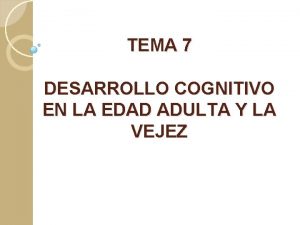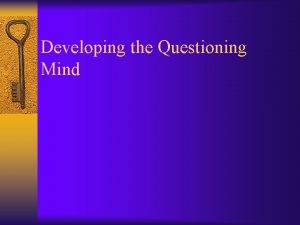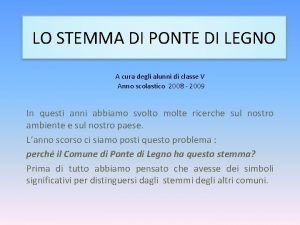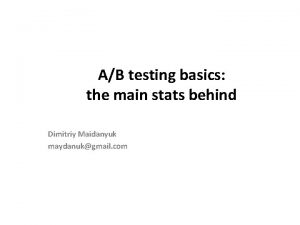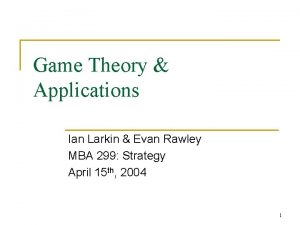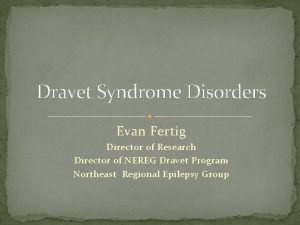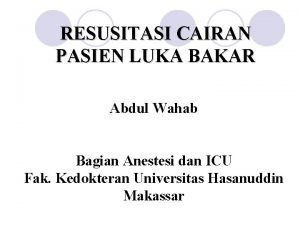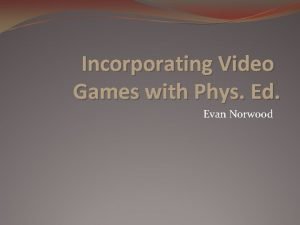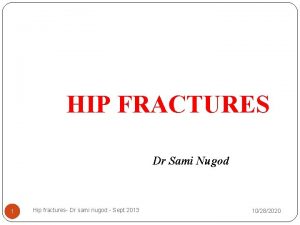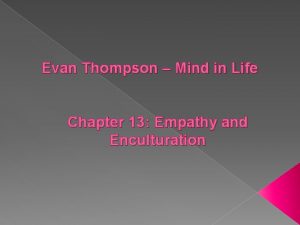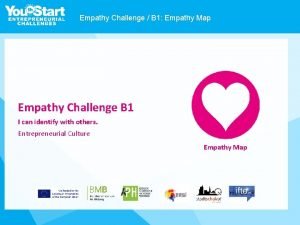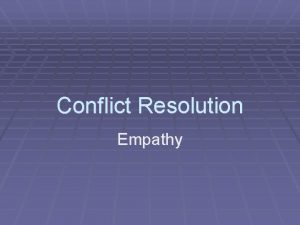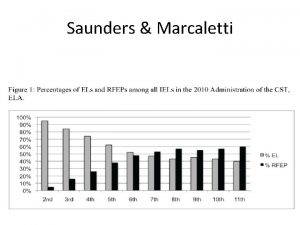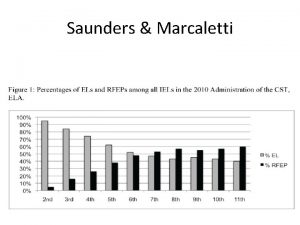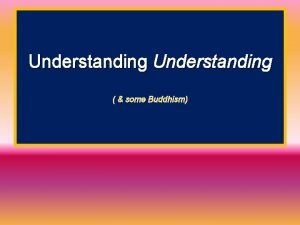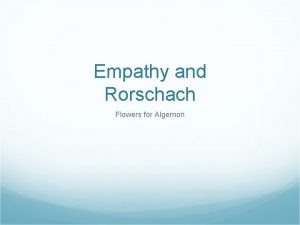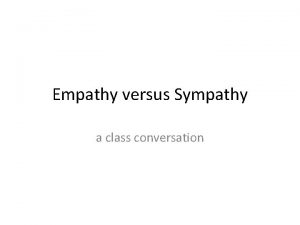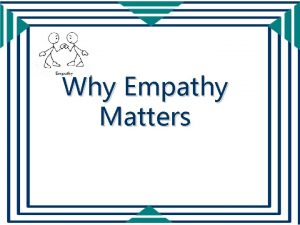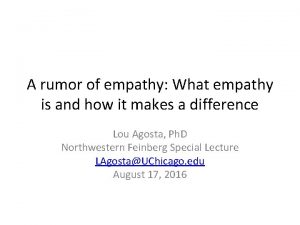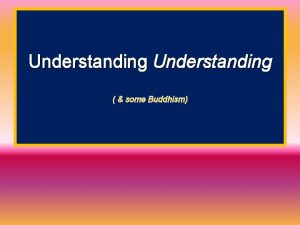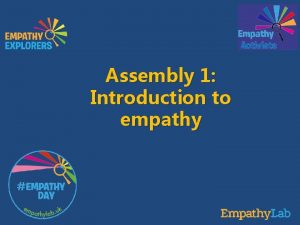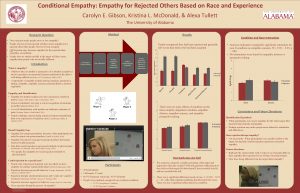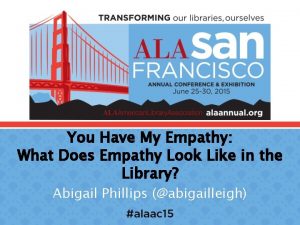Evan Thompson Mind in Life Chapter 13 Empathy





























- Slides: 29

Evan Thompson – Mind in Life Chapter 13: Empathy and Enculturation

Aim: Building a bridge between mind science and Husserl’s genetic/generative phenomenology of intersubjectivity • Two central ideas: • (i) Self and other enact each other reciprocally through empathy. • (ii) Human subjectivity emerges from developmental processes of enculturation and is configured by the distributive cognitive web of symbolic culture. NO MIND IS AN ISLAND.

Subchapters: • A) Intentionality and Open Intersubjectivity (pp. 383 -386) • B) The Phenomenological Concept of Empathy (pp. 386 -393) • C) Affective and Sensorimotor Coupling (pp. 393 -395) • D) Imaginary Transposition (pp. 395 -397) • E) Mutual Self and Other Understanding (pp. 398 -401) • F) Moral Perception (p. 401 f. ) • G) Enculturation (pp. 402 -411)

A) Intentionality and Open Intersubjectivity (pp. 383 -386) • 1) Intentionality is phenomenologically seen openness toward the world, i. e. (also) implying intersubjectivity: • a) We encounter cultural artifacts/equipment, not indifferent physical objects. • b) We perceive objects that appear to us as perceivable by other possible subjects.

A) Intentionality and Open Intersubjectivity (pp. 383 -386) • “Appresentation” (Husserl): Perception automatically “appresents” hidden/absent profiles (e. g. backsides) of objects through the perception of the visible ones. • The “meaning” of “object” implies being simultaneously perceivable by a plurality of other subjects.

Reaction times for object recognition (Eleanor Rosch, 1981)

A) Intentionality and Open Intersubjectivity (pp. 383 -386) • But (i): Is the unity of the object the result of past and possible future perceptions? ET: no! • But (ii): Is the unity of the object the result of possible (theoretical), but nonfactual perceptions? ET: no! • Instead: The unity of the object is better understood as the transcendence of one’s individual stance and implying its perceptibility by other subjects. • Problems: ET seems to dismiss (i) too hasty and in an unsatisfactory way. And: The question of privileged perspectives is not discussed.

A) Intentionality and Open Intersubjectivity (pp. 383 -386) • 2) Intersubjectivity as the experience of the bodily presence of the other (face-to-face experience). • 3) Generative intersubjectivity of transferred norms, conventions, traditions. • However, 2) and 3) presuppose the open intersubjectivity of perceptual experience - as a basic (formal) structural feature of intentionality.

B) The Phenomenological Concept of Empathy (pp. 386 -393) • • Traditionally: Empathy (i): Feeling what another person is feeling. Empathy (ii): Knowing what another person is feeling. Empathy (iii): Responding compassionately to another person’s distress (sympathy). • Phenomenologically: • Any intentional act that directly discloses/presents the other’s experience (not an inference from perception of the other’s behavior).

B) The Phenomenological Concept of Empathy (pp. 386 -393) • Edith Stein: Some kind of “appresentation” – analogy between empathy and the perception of averted sides of objects. • BUT: Empathy is “nonprimordial”, i. e. an experience cannot be disclosed in its original first-person subjectivity (the averted sides cannot in principle be “perceived”). Cf. also memory and imagination.

B) The Phenomenological Concept of Empathy (pp. 386 -393) • 3 levels/modalities of (theoretical) empathical accomplishment (Stein): • (i) The emergence of another’s experience, as an “object”. • (ii) The mental transposition into another’s experience. • (iii) The clarified objectification of another’s experience. • AND: Reflexive/reiterated empathy - I feel that the other feels that I feel.

B) The Phenomenological Concept of Empathy (pp. 386 -393) • 5 levels of empathically experiencing another as a living bodily subject (Stein): • (i) As animated by its own fields of sensation (emergence of another’s experience). • (ii) As animated by general feelings of life/vitality (aging, health, sickness etc. ), i. e. delving into the content of another’s experience. This “sensual empathy” presupposes comparable body schemas between oneself and the other. • (iii) As expressive of subjective experiences (where the empathetic perception of facial expressions is paradigmatic).

B) The Phenomenological Concept of Empathy (pp. 386 -393) • (iv) As another center of orientation in a common spatial world. • (v) As a locus of intentional agency and voluntary movement. • Reiterated empathy: seeing oneself from another’s empathetic experience of oneself. The sense of personal selfhood is tied to another’s recognition of oneself as sentient.

B) The Phenomenological Concept of Empathy (pp. 386 -393) • 4 types of empathetic processes: • (i) The involuntary coupling of one’s living body with another’s living body in perception/action. • (ii) The imaginary transposition of oneself into another’s place. • (iii) The reciprocal understanding of “you” as an “other” to “me”, and of “me” as an “other” to “you”. • (iv) The moral perception of another as a person. • The following subchapters’ aim: • To sketch a neurophenomenological framework for the scientific study of empathy.

C) Affective and Sensorimotor Coupling (pp. 393 -395) • Affective/sensorimotor empathy: the dynamic coupling of the living bodies of self and other, i. e. as an associative bonding on the basis of bodily similarity (unconscious body schemas). • Mirror neurons: In monkeys, same patterns of neural activity when accomplishing certain goal-directed hand movements as when observing these movements performed by others. • Functional magnetic resonance imaging (f. MRI) studies on humans have revealed similar mirroring/resonance effects - with regard to sensorimotor coupling as well as affective coupling.

D) Imaginary Transposition (pp. 395 -397) • Cognitive empathy: one’s mental adoption of another’s perspective by imaginary transposition. • Not an all-or-matter phenomenon; rather, a matter of degree. • Monkeys : to some extent capable of imaginary transposition. • Human children: emergence of imaginary transposition at around 9 -12 months of age.

D) Imaginary Transposition (pp. 395 -397) • Joint attentional interactions with adults (e. g. gaze following, joint engagement with objects, imitative learning) when others are understood as intentional agents like themselves. • An open question: Self-understanding first, as a basis for understanding the other? Or a simultaneous development of both?

E) Mutual Self and Other Understanding (pp. 398 -401) • Reiterated empathy: the empathetic experience of another as empathetically experiencing oneself (the experience of oneself as another for the other). • Human children: During joint attention sometimes the focus lies on the child itself, i. e. it becomes aware of that it is monitored by another (possibility of developing e. g. shyness, self-consciousness, sense of self-esteem). • Basis for a non-egocentric/intersubjective perspective on oneself as participant in social interaction, (as an individual intentional agent in a public world). • Framework for language acquisition, symbolic representation, and communicative conventions.

F) Moral Perception (p. 401 f. ) • Moral empathy: the experience of another as someone deserving concern and respect, emerging together with the understanding of others as mental agents (in Kantian terms: as ends-in-themselves). • Basis for the establishment of moral principles, though not fully exhausting “moral experience”. • Problems: What is a “moral experience”? Why couldn’t moral principles be established without basic moral empathy (e. g. from a selfish, game-theoretical perspective)?

G) Enculturation (pp. 402 -411) • A shift to cultural and historical intersubjectivity: human mental activity is fundamental social and cultural, esp. shaped by symbolic culture (enculturation). • Developmental systems theory: • - Against dichotomy “nature vs. culture”. • - Against primacy of genes as information carriers; rather, multiple interdependent causal factors – genetic, cellular, social, as well as cultural.

G) Enculturation (pp. 402 -411) • Stably replicated features of human culture contribute substantially to the constitution of human psychology. • Example: joint attention and cultural learning – basis for acquisition of language/symbolic representation/various cognitive capacities. Cf. Tomasello. • Presuppositions: children’s abilities to understand communicative acts/intentions and to engage in rolereversal imitation, i. e. to learn to use communicative symbols in the same way as the adult. • The whole joint attentional scene is understood from an external perspective: the child and the adult are represented in the same non-egocentric format and are interchangeable.

G) Enculturation (pp. 402 -411) • The whole joint attentional scene is understood from an external perspective: the child and the adult are represented in the same non-egocentric format and are interchangeable. • Role-reversal imitation in communication. • Language utterances are perspectival: they imply choices, direct attention to certain aspects (e. g. , the oak, that tree, … is standing, was placed in, …; p. 407; Tomasello), also with regard to the listener’s interests/attentional status. • Language acquisition involves internalization of multiple perspectives and communicative intentions (internalization of joint attention) into symbolic representation.

G) Enculturation (pp. 402 -411) • 3 ways in which language fashions basic cognitive skills into more complex ones (Tomasello): • (i) Linguistic communication is a vehicle for the transmission of (accumulated) cultural knowledge. • (ii) Linguistic communication influences children’s construction of cognitive categories, relations, analogies, metaphors. • (iii) Linguistic interaction with others induces children to take different conceptual perspectives.

G) Enculturation (pp. 402 -411) • Relationship between symbolic enculturation and the brain: • (i) Symbolic systems emerge from the interactions of many individuals, not in isolated “brains”. • (ii) Hypothesis: The cultural environment of symbolic representation can alter the neural architecture of the developing brain (deep enculturation). Neural constructivism.

G) Enculturation (pp. 402 -411) • “The 'Other Half' is the word. The 'Other Half' is an organism. Word is an organism. The presence of the 'Other Half' is a separate organism attached to your nervous system on an air line of words can now be demonstrated experimentally. One of the most common 'hallucinations' of subject during sense withdrawal is the feeling of another body sprawled through the subject's body at an angle. . . yes quite an angle it is the 'Other Half' worked quite some years on a symbiotic basis. From symbiosis to parasitism is a short step. The word is now a virus. The flu virus may have once been a healthy lung cell. It is now a parasitic organism that invades and damages the central nervous system. Modern man has lost the option of silence. Try halting sub-vocal speech. Try to achieve even ten seconds of inner silence. You will encounter a resisting organism that forces you to talk. That organism is the word. “

G) Enculturation (pp. 402 -411) • ”The Ticket That Exploded” (1962), William S. Burroughs • ”Snow Crash” (1992), Neal Stephenson • “The Diamond Age: Or, A Young Lady's Illustrated Primer” (1995), Neal Stephenson

G) Enculturation (pp. 402 -411) • Individual subjectivity is from the outset intersubjectivity: the internalized result of communally handed down norms, conventions, symbolic artifacts, and cultural traditions. • The internalization of symbolic systems implies the whole historically derived conglomeration of what forebears in the culture have found useful to manipulate the attention of others in the past, i. e. different attentional construals of any given situation.

G) Enculturation (pp. 402 -411) • 3 time scales of generative processes : • (i) Phylogeny: evolvement of social cognition, based on identification with other humans as intentional/mental beings, long-term awareness, cognitive/ emotional selfregulation, voluntary attentional control. • (ii) History: time of cumulative cultural evolution, with imitative learning and innovation as preconditions. • (iii) Ontogeny: children learn/ encounter their physical/social worlds through the mediating lenses of preexisting cultural artifacts (unidirectional “ratchet effect”, cf. Tomasello).

G) Enculturation (pp. 402 -411) • Phylogeny is intertwined with history and ontogeny: • Human evolution is the evolution of developmental systems, including the evolution of childhood and social cognition, depending on the generative/ generational processes of human culture.
 Thompson y thompson
Thompson y thompson Mind master logo
Mind master logo A wondering mind is an unhappy mind
A wondering mind is an unhappy mind A questioning mind
A questioning mind Evan hunter the last spin
Evan hunter the last spin Chris anaya
Chris anaya Evan akselrad
Evan akselrad Evan loeffler
Evan loeffler Evan bieske
Evan bieske Pax van tibi geli mar sta ce e meus traduzione
Pax van tibi geli mar sta ce e meus traduzione Evan elder stanford
Evan elder stanford Xavier rival
Xavier rival Evan seiden
Evan seiden Evanmiller.org ab testing
Evanmiller.org ab testing Evan williams berkeley
Evan williams berkeley Evan sauve
Evan sauve On the sidewalk bleeding by evan hunter
On the sidewalk bleeding by evan hunter Magiccsg
Magiccsg Evan duffy parlee
Evan duffy parlee Evan fertig
Evan fertig Evan waxman
Evan waxman Evan fertig md
Evan fertig md Evan ramsey alaska
Evan ramsey alaska Rumus parkland baxter
Rumus parkland baxter Macrominerals
Macrominerals Mobeyday.com
Mobeyday.com Evan norwood
Evan norwood Evan korth
Evan korth Evan korth rate my professor
Evan korth rate my professor Seinsheimer classification
Seinsheimer classification
